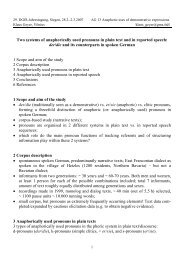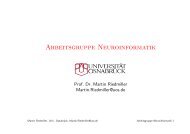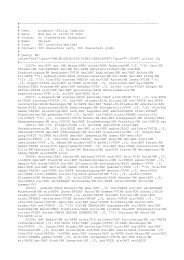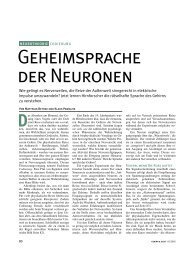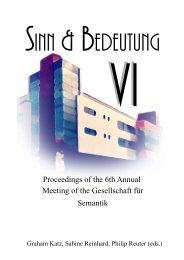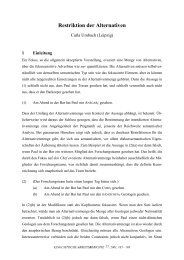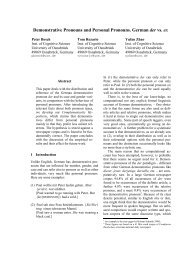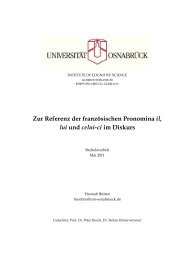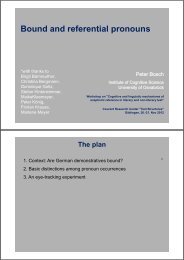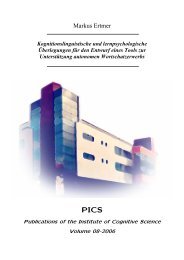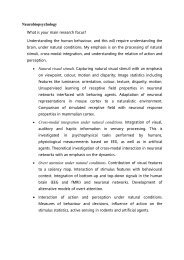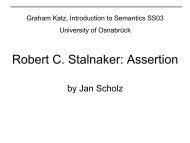Analogical Reasoning: A Core of Cognition - Institut für Geoinformatik
Analogical Reasoning: A Core of Cognition - Institut für Geoinformatik
Analogical Reasoning: A Core of Cognition - Institut für Geoinformatik
You also want an ePaper? Increase the reach of your titles
YUMPU automatically turns print PDFs into web optimized ePapers that Google loves.
<strong>Analogical</strong> <strong>Reasoning</strong>: A <strong>Core</strong> <strong>of</strong> <strong>Cognition</strong><br />
Helmar Gust, Ulf Krumnack, Kai-Uwe Kühnberger, Angela Schwering<br />
Analogies have always been considered a central part <strong>of</strong> human intelligence and cognition. This survey <strong>of</strong>fers an overview<br />
<strong>of</strong> analogical reasoning and its applications, showing that analogies are an important element <strong>of</strong> various cognitive abilities<br />
like memory access, adaptation, learning, reasoning, and creativity. Therefore, analogies can provide a basis for integrated<br />
large-scale cognitive systems.<br />
1 Introduction<br />
Analogy research has a long history and was subject <strong>of</strong> investigation<br />
on various levels: Ancient Greek philosophy examined<br />
analogy as a proportional relation between objects. In belletristic<br />
texts, metaphors use analogy implicitly to describe objects in<br />
a figurative way. In natural sciences, analogy is an indispensable<br />
tool for scientific progress [18].<br />
While classical research on analogy mainly deals with higherlevel<br />
intelligent behavior, the focus in cognitive science has<br />
shifted to the examination <strong>of</strong> more basic cognitive abilities, relevant<br />
for agents interacting with their environment. Many <strong>of</strong><br />
these abilities seem to rely on analogy as well and thereby give<br />
an explanation for the analogical capacity on the higher-level.<br />
Therefore, it is not astonishing that analogy plays a central role<br />
in cognitive science research.<br />
2 What is Analogy?<br />
Analogy making is a highly sophisticated cognitive process in<br />
which two conceptualizations - a source and a target - are analyzed<br />
for common structural patterns [6]. In analogies, source<br />
and target are typically <strong>of</strong> different domains (for metaphors this<br />
is even essential). The purpose <strong>of</strong> analogies is to adapt knowledge<br />
available about the source conceptualization such that it<br />
can be applied to the target in a way that new analogous inferences<br />
can be drawn. Analogy making requires intelligence since<br />
analogous patterns and transfers <strong>of</strong>ten are not obvious and depend<br />
on a certain conceptualization <strong>of</strong> the domains.<br />
Metaphors and analogies occur in a large variety <strong>of</strong> domains,<br />
as well as in quite different forms. In order to classify certain<br />
aspects and properties <strong>of</strong> analogies, three types <strong>of</strong> analogies are<br />
<strong>of</strong>ten distinguished 1 [14, 22]: First, proportional analogies have<br />
the general form (A : B) :: (C : X). Proportional analogies<br />
can be in domain which means that A, B, C are expressions from<br />
the same domain. This type is characteristic for intelligence test<br />
where the subjects have to continue a sequence <strong>of</strong> geometric figures<br />
[4] or numbers and strings [12]. Proportional analogies can<br />
also be cross domain. In this case, A and B establish a relation<br />
in the source domain which should be applied to a concept C<br />
<strong>of</strong> the target domain to get the result X in the target domain.<br />
1 We do not claim that the following classification <strong>of</strong> analogies is<br />
complete, nor that it is the only possible one. Rather such a classification<br />
can be useful to specify different properties <strong>of</strong> analogies.<br />
Proportional analogies have a nice counterpart in metaphoric<br />
expressions. For example, a statement like Gills are the lungs <strong>of</strong><br />
fish can be analyzed as the solution to the following analogy:<br />
mammals : lungs :: fish : X. Here the word gills refers to whatever<br />
the analogical relation constructs for X. What is mentioned<br />
in the surface structure <strong>of</strong> the metaphoric expression is typically<br />
a cross domain role relation meaning X plays the role <strong>of</strong> lungs<br />
to fish, while the reference to the counterpart <strong>of</strong> fish (mammals)<br />
is assumed to be derivable by background knowledge.<br />
A second type <strong>of</strong> analogies are predictive analogies. They<br />
describe a new domain (target) not only by specifying structural<br />
commonalities with a given domain (source), but also by<br />
transferring information and explanations from the source to<br />
the target [5, 13]. Besides the classical domain <strong>of</strong> metaphoric<br />
expressions, complex conceptualizations <strong>of</strong> correlations between<br />
seemingly different physical domains are good examples for such<br />
analogies. They relate physical domains which are hardly accessible<br />
by our direct experience to domains which have perceivable<br />
properties. The importance <strong>of</strong> analogies becomes evident<br />
in cases where such working analogies are not available. Why is<br />
relativity theory or quantum mechanics so hard to conceive by<br />
humans? The main reason is, because the analogical transfer to<br />
a domain which is accessible to our direct experience essentially<br />
fails. There are many other examples in modern physics where<br />
no good analogies are available or strange metaphors are used<br />
which do not explain very much: consider for example the waveparticle<br />
dualism, exchange forces (based on photons, gravitons<br />
etc.), or string theory.<br />
The third type <strong>of</strong> analogy, analogical problem solving, can be<br />
used to solve a problem by transferring a solution from a wellknown<br />
domain to an unknown domain. Case-based reasoning<br />
[16] formalizes approaches <strong>of</strong> this type. Other examples are the<br />
famous tumor-fortress problem [8] or the usage <strong>of</strong> program code<br />
for developing new programs by abstraction [23].<br />
Another aspect connected to analogies is the reconceptualization<br />
<strong>of</strong> known domains (called rendition). This<br />
may occur if an obvious analogy fails. A classical example is the<br />
conceptualization <strong>of</strong> a paintbrush as a tool to transfer paint to<br />
a canvas by pumping paint in contrast to smearing it [14]. In<br />
general, verifying hypotheses about allegedly known (real world)<br />
situation (source) by experiments in a controlled lab environment<br />
(target) uses an analogical relation between both domains. The<br />
outcome <strong>of</strong> such an experiment may force us to reconceptualize<br />
the source domain.<br />
It is <strong>of</strong>ten mentioned that metaphors are strongly connected
Figure 1: Analogies in cognitive processes.<br />
to analogies [7, 14]. Depending on the context one and the<br />
same metaphor can be proportional or predictive. Assume for<br />
example a situation in which a teacher is lecturing students<br />
on elementary atom physics by giving the following metaphor<br />
describing the Rutherford analogy:<br />
(1) Electrons are the planets <strong>of</strong> the atom.<br />
(1) can be interpreted as a predictive analogy: The students<br />
learn a new conceptualization <strong>of</strong> the atom. On the other hand,<br />
for a scientist (1) can be simply interpreted as a (historically<br />
important) proportional analogy.<br />
The process <strong>of</strong> analogy making can be subdivided into several,<br />
interrelated tasks. Typically, the following three subtasks<br />
can be identified: retrieval, mapping, and transfer.<br />
At the beginning, when exposed to a new situation (the target),<br />
a source domain has to be identified to which that situation<br />
can be related. Some retrieval technique has to be applied to<br />
search the memory for items which seem like candidates for an<br />
analogy. In certain settings, such as intelligence tests or teaching<br />
situations, the source domain may be given explicitly. Some<br />
models for analogy making even view this as the standard case<br />
and do not provide special means <strong>of</strong> retrieval.<br />
The mapping phase aims to establish the analogical relation<br />
between these two domains, i.e. the alignment <strong>of</strong> structures<br />
from both domains. In general, there are many possible mappings<br />
and which one is appropriate depends on the context and<br />
the goal <strong>of</strong> the analogy. Two problems are typically discussed associated<br />
with the mapping step. The relevance problem consists<br />
<strong>of</strong> identifying the parts <strong>of</strong> the domains that are relevant within<br />
the context <strong>of</strong> the analogy and therefore shall enter the analogical<br />
relation. The representation problem is concerned with the<br />
difficulties in mapping caused by differently structured representations<br />
<strong>of</strong> the domains. While it may seem plausible that two<br />
domains are represented in an isomorphic way when they are<br />
especially prepared for the analogy, this seems unlikely in general.<br />
Therefore the mapping may guide a restructuring <strong>of</strong> one or<br />
both domains and a good deal <strong>of</strong> the explanatory and creative<br />
power <strong>of</strong> analogies can actually be ascribed to that process <strong>of</strong><br />
re-representation.<br />
During the transfer phase the analogical relation is used<br />
to translate information between the two domains. Normally<br />
knowledge is transferred from the source to the target domain<br />
and is used there to introduce new concepts or structures, give<br />
new explanations to phenomena, or solve given problems. This<br />
new knowledge is in no way logically justified and should merely<br />
be seen as a hypothesis, but when used carefully, it can be the<br />
source <strong>of</strong> valuable inspiration.<br />
In some cases, these three phases are supplemented by additional<br />
steps, such as evaluation <strong>of</strong> the transferred knowledge,<br />
or the induction <strong>of</strong> generalized rules, depending on the model<br />
applied and the context in which analogy making is placed.<br />
3 Cognitive Abilities in Analogies<br />
Analogies are paramount for understanding many cognitive phenomena.<br />
Figure 1 illustrates the process <strong>of</strong> analogy making and<br />
relates cognitive abilities to the different stages. In the following,<br />
we describe in detail each <strong>of</strong> these abilities.<br />
3.1 Memory and Adaptation<br />
The ability to store information and recall it on given occasions<br />
is crucial to an appropriate use <strong>of</strong> memory. As every new situation<br />
includes a lot <strong>of</strong> details making it unique and different<br />
from previous experiences, a retrieval process making memories<br />
usable for that situation heavily relies on analogy. Irrelevant details<br />
must be blinded out, old patterns have to be mapped to<br />
new domains. So the recall <strong>of</strong> information from memory is a<br />
sophisticated process with close resemblance to the phases <strong>of</strong><br />
retrieval, mapping and transfer described above.<br />
Kokinov [15] proposes a cognitive architecture in which<br />
memory plays the central role, to address cognitive processes<br />
like analogical reasoning and the estimation <strong>of</strong> semantic similarity.<br />
The system consists <strong>of</strong> a network, the DUAL memory,<br />
representing the system’s world knowledge. The nodes <strong>of</strong> the<br />
network, called micro-agents, have an inner structure and are<br />
in a state affecting their behavior in cognitive processes. Such<br />
processes are triggered by activation potential and marker passing<br />
along the connections between the micro-agents. An initial<br />
activation pattern is determined by context and then propagated<br />
according to the characters <strong>of</strong> the individual agents and their interconnections.<br />
The activation pattern represents the contents<br />
<strong>of</strong> the short-term memory, while the whole micro-agent network<br />
corresponds to long-term memory.<br />
Based on this memory architecture, different types <strong>of</strong> retrieval<br />
and reasoning can be performed. For example, the framework<br />
has been demonstrated to be capable <strong>of</strong> analogical problem<br />
solving: given the task to heat water in a wooden vessel in a<br />
forrest with only matches and a pocket knife the system proposed,<br />
analogous to an immersion heater, to warm up the knife<br />
and then put it into the water.<br />
A totally different approach to memory are Vector Symbolic<br />
Architectures (VSAs) [19]. This approach uses high-dimensional<br />
vectors to store information by simple mathematical operations<br />
like addition and multiplication. Storage and retrieval can be<br />
carried out via the same set <strong>of</strong> operators which can also be<br />
used to realize some kind <strong>of</strong> analogical access. From a vector<br />
that holds the information Paris is the capital <strong>of</strong> France and<br />
Stockholm is the capital <strong>of</strong> Sweden, questions like What is the<br />
relation <strong>of</strong> Paris and France? and What is the capital <strong>of</strong> Sweden?<br />
can be answered. But it is also possible to retrieve statements<br />
not explicitly stored in the memory, such as the solution to the<br />
analogy task Paris is to France like X is to Sweden.
3.2 <strong>Reasoning</strong><br />
Human cognitive reasoning capacities include the classical inference<br />
mechanisms: Deduction infers knowledge given implicitly<br />
by known facts and rules: if the premises evaluate true, deduction<br />
infers according to the rule that the conclusion is true as<br />
well. Inductive reasoning creates knowledge via generalization<br />
over a large set <strong>of</strong> cases which share a common fact or rule and<br />
induces a general rule. Abduction is reasoning from an effect to<br />
its cause: from a known general rule and a true conclusion it is<br />
hypothesized that the premise is true as well.<br />
Beside these classical reasoning mechanisms, human reasoning<br />
capacities include analogical reasoning, too. Moreover,<br />
analogical reasoning can imitate the classical forms <strong>of</strong> reasoning:<br />
if an analogy completes a causal relation on the target side by<br />
a missing premise it resembles an abductive inference and if it<br />
transfers the conclusion it resembles a deductive inference.<br />
While a deductive inference is truth-preserving, inductive,<br />
abductive and analogical inferences are not. But the likeliness<br />
<strong>of</strong> inductive inferences increases with the number <strong>of</strong> valid cases.<br />
Therefore the set <strong>of</strong> cases must be sufficiently large to draw<br />
sound conclusions. <strong>Analogical</strong> reasoning, however, requires only<br />
two cases: the likelihood <strong>of</strong> analogical inferences increases with<br />
the number <strong>of</strong> analogical matches between the source and the<br />
target [25].<br />
We distinguish two types <strong>of</strong> analogical inferences: Either it<br />
comprises only the transfer <strong>of</strong> a structural relationship between<br />
two elements. Or analogical transfer refers to a general rule.<br />
Applying the rule from the source domain, new inferences can<br />
be drawn in the target domain. However, in both cases the analogical<br />
inference is based on the uncertain analogical mapping<br />
which must not necessarily be true.<br />
3.3 Learning by Transfer<br />
In artificial intelligence, a large number <strong>of</strong> different learning theories<br />
were proposed. Two major types <strong>of</strong> learning theories can<br />
be distinguished: Lazy learning algorithms store each example<br />
explicitly in a database without identifying abstract features.<br />
Instance-based learning [1], case-based learning [16], or memorybased<br />
learning [24] are representatives <strong>of</strong> this learning type. Eager<br />
learning algorithms minimize the storage load by an abstraction<br />
process. The identification <strong>of</strong> important (common) features<br />
<strong>of</strong> the examples is a necessary prerequisite for this type <strong>of</strong> learning<br />
algorithm. Examples for techniques <strong>of</strong> learning are decisiontree<br />
learning [21], inductive learning [17], or connectionist-style<br />
learning [2].<br />
Both classes <strong>of</strong> learning strategies are based on a common<br />
idea: As input data a (more or less) large sample <strong>of</strong> examples is<br />
needed to guarantee a successful learning procedure. Contrary<br />
to these approaches, cognitive learning seems to be based on<br />
a significantly less amount <strong>of</strong> training data and occurs <strong>of</strong>ten<br />
in the form <strong>of</strong> implicit learning. We propose to explain these<br />
discrepancies by analogical learning.<br />
In the case <strong>of</strong> analogical learning a conceptualization <strong>of</strong> the<br />
source domain is sufficient to generate knowledge about the<br />
target domain. Moreover, a projection <strong>of</strong> attributes and relations<br />
from the source to the target can productively introduce new<br />
concepts on the target domain. As a result cognitive agents<br />
can learn a new conceptualization <strong>of</strong> the target domain without<br />
perceiving a huge number <strong>of</strong> examples.<br />
Figure 2: The analogy between a water pipe system and an<br />
electric circuit in a diagrammatic representation. The Figure<br />
contains more information than necessary for an interpretation<br />
<strong>of</strong> the metaphorical description.<br />
A prototypical situation in which analogical learning plays<br />
an important role are teaching situations. When the teacher<br />
explains an electric circuit by analogy with a water-flow system<br />
(Figure 2), the student needs to establish an analogical relation<br />
between the involved domains. 2 Only if the student successfully<br />
transfers the flow <strong>of</strong> water to the target domain she will reach<br />
the conclusion that current is flowing in the electric circuit.<br />
A famous approach for such types <strong>of</strong> transfers is the structure<br />
mapping theory (SMT) where two graphs are used to represent<br />
models <strong>of</strong> the source and target domain [5]. An alignment<br />
process searches a maximal match <strong>of</strong> subgraphs. The algorithm<br />
returns an analogical relation between the two domains.<br />
Learning in SMT is realized by transferring relevant parts <strong>of</strong> the<br />
source graph which have not been aligned [6]. The alignment<br />
and transfer process is guided by principles ensuring consistency<br />
<strong>of</strong> the hierarchical relational structure.<br />
3.4 Learning by Abstraction<br />
Whereas a transfer <strong>of</strong> information from the source to the target<br />
yields a new conceptualization <strong>of</strong> the target domain, learning<br />
in the classical sense is concerned with finding hypotheses<br />
that generalize the training examples to unseen test examples.<br />
This aspect is covered by learning by abstraction: Instead <strong>of</strong><br />
a plain mapping, the following two-layered procedure is considered.<br />
First, identify the common structure <strong>of</strong> source and target<br />
by a generalization. Second, calculate the mapping <strong>of</strong> objects<br />
<strong>of</strong> the source to objects <strong>of</strong> the target via the common structure.<br />
Particularly with respect to certain application domains <strong>of</strong><br />
analogies like the string domain this abstraction process seems<br />
to be crucial. In H<strong>of</strong>stadter’s analogy model Copycat [12], string<br />
sequences like ababab need to be represented at a more abstract<br />
level as 3 ∗ (ab) to recognize the analogical relation to strings<br />
like ccc.<br />
A formal theory for computing analogies via an abstraction<br />
process is proposed in [11]: Heuristic-Driven Theory Projection<br />
(HDTP) is an algorithmic approach to calculate a common generalization<br />
<strong>of</strong> a source and a target. The underlying mathematical<br />
model for such generalizations is anti-unification [20]. Constraints<br />
are given by the problem structure or by the functional<br />
role the objects play in a given structure.<br />
2 c.f. http://hyperphysics.phy-astr.gsu.edu/hphys.html
Figure 3: A graphical representation <strong>of</strong> learning stages.<br />
In HDTP’s logical framework, source, target, and generalization<br />
are given by theories T hS, T hT , and T hG respectively.<br />
Comparing attracts(sun,planet) from T hS to attracts(nucleus,electron)<br />
to T hT in a logical representation <strong>of</strong><br />
the Rutherford analogy (section 2), this procedure would result<br />
in the generalization attracts(central body,orbiter) in T hG,<br />
where central body and orbiter are variables. (1 st<br />
level<br />
<strong>of</strong> Figure 3). By calculating the abstraction, the mapping<br />
{central body↦→sun/nucleus, orbiter↦→planet/electron} is obtained<br />
which represents two substitutions: Θ1 from T hG to<br />
T hS and Θ2 from T hG to T hT . The generalized theory T hG<br />
comprises the common structures <strong>of</strong> source and target: in the<br />
Rutherford analogy the generalization <strong>of</strong> the solar system and<br />
the atom can be conceptualized as a central force system.<br />
In HDTP, learning occurs as a side-effect <strong>of</strong> the modeling<br />
and can be considered as being implicit: the generalization<br />
process yields new conceptualizations <strong>of</strong> the target domain at<br />
an abstract level for no additional costs. In a uniform way, it<br />
provides a structural description <strong>of</strong> the underlying domains in<br />
terms <strong>of</strong> a generalized theory.<br />
<strong>Analogical</strong> learning in HDTP does not end with a successful<br />
establishment <strong>of</strong> an analogical relation, but learning continues in<br />
stages. After the most specific generalization is established (1 st<br />
level), the inductive refinement (2 nd level) adjusts the parameters<br />
in order to find a new (and finer) conceptualization <strong>of</strong> source<br />
an target. The 3 rd level aims to identify general principles that<br />
can be applied in a variety <strong>of</strong> domains.<br />
In plain structure mapping as well as in mapping via abstraction,<br />
the greatest common sub-structure <strong>of</strong> source and target<br />
must be identified. But in mapping via abstraction, the common<br />
structure is not forgotten but represented explicitly. Instead<br />
<strong>of</strong> mapping one object directly onto another, it is mapped via<br />
the role it is playing in the common structure.<br />
3.5 Creativity<br />
Creativity as defined in [3, p. 205] is “the production <strong>of</strong> an idea,<br />
action, or object that is new and valued”. Analogies can provide<br />
a means for creativity, as they can introduce new concepts<br />
into a domain via analogical transfer. The principles guiding the<br />
transfer ensure that the concepts are relevant in order to understand<br />
the target domain. Furthermore analogies can induce new<br />
insights about a domain by reconceptualizations.<br />
From the very beginnings, artificial intelligence struggles<br />
hard to develop models for creativity. Nevertheless these<br />
endeavors were not very successful so far. Perhaps analogical<br />
reasoning can provide a way out <strong>of</strong> this dead end. 3 Examples<br />
<strong>of</strong> analogy related creativity can be seen in natural language:<br />
(2) He reached the maximal height <strong>of</strong> his career.<br />
(3) Gills are the lungs <strong>of</strong> fish.<br />
(4) My brain is a little foggy.<br />
(5) Juliet is the sun.<br />
These metaphors govern the creation <strong>of</strong> new concepts to a<br />
different extent. Height <strong>of</strong> career in (2) seems to be a conventional<br />
metaphor, i.e. the constituent is lexicalized and therefore<br />
an idiom. In (3) the new concept gills is strongly determined by<br />
the source domain. In (4) the meaning <strong>of</strong> the adjective foggy<br />
has to be adapted to be applicable to brain states. Shakespeare’s<br />
metaphor in (5) is at a very abstract level and it remains relatively<br />
vague which properties are transferred.<br />
Another domain for which creativity in analogies is an important<br />
aspect are examples from the physical domain like the<br />
former mentioned water-current analogy. 4 Figure 2 depicts the<br />
situation between a water-flow circuit and an electric circuit.<br />
Although there is no possibility to observe current flowing in<br />
an electric circuit directly, humans are able to establish such an<br />
abstract concept in analogy to water flowing in a water pipe<br />
system.<br />
How can analogical reasoning explain these creative abilities?<br />
An answer can be provided by combining the transfer <strong>of</strong><br />
facts and rules from the source to the target (section 3.2) with<br />
abstraction and generalization (section 3.4). In (6), current is<br />
explicitly associated with water, but the properties <strong>of</strong> current are<br />
not specified. In fact, even if a student has no idea which properties<br />
should be ascribed to current (for example, in a learning<br />
scenario), (6) could be the cue to get the flowing conceptualization<br />
<strong>of</strong> current by transferring properties <strong>of</strong> water from the<br />
source to the target. This transfer enables the learner to create<br />
properties <strong>of</strong> current like flowing-in-circuit or the necessity <strong>of</strong><br />
a pressure source, provided the modeling and the background<br />
knowledge is fine-grained enough.<br />
In particular, analogies in qualitative reasoning applied to<br />
the physics domain are good examples for creative concept formations:<br />
a famous and extensively discussed example is the creation<br />
<strong>of</strong> the concept heat in a water-flow vs. heat-flow scenario<br />
[22, 9]. In this scenario, the abstract concept heat-flow needs to<br />
be creatively generated by the analogy, although heat is neither<br />
observable nor measurable. Projecting the situation in a waterflow<br />
system to the situation in which the temperature <strong>of</strong> a cup<br />
<strong>of</strong> c<strong>of</strong>fee is decreasing and the temperature <strong>of</strong> a metallic cube<br />
is increasing (both are connected by a metal bar), the successful<br />
establishment <strong>of</strong> an analogy introduces a concept heat-flow,<br />
explaining the changes in the setting.<br />
4 Conclusions and Future Directions<br />
In this article, we argued that analogical reasoning is a crucial<br />
issue for cognition. Classical cognitive abilities <strong>of</strong> human agents<br />
such as memory capacities, learning by transfer, learning by abstraction,<br />
forms <strong>of</strong> reasoning, and creativity can be considered<br />
3 Examples <strong>of</strong> creative aspects <strong>of</strong> analogies can be found in [14].<br />
4 A precise modeling <strong>of</strong> this analogy can be found in [10].
as necessarily interconnected with and in an important respect<br />
governed by the capacity to establish analogical relations. In<br />
a certain sense these capacities (typically considered to be distinct)<br />
can be explained by analogies in a rather unified manner.<br />
Clearly the proposed modeling <strong>of</strong> a variety <strong>of</strong> cognitive<br />
phenomena can be interpreted as a reductionist position<br />
<strong>of</strong> cognition where several seemingly incoherent aspects <strong>of</strong><br />
cognition can be reduced to one general principle underlying the<br />
whole system. Although we clearly do not claim that cognition<br />
as a whole is nothing else but analogy making, the possibility<br />
<strong>of</strong> a reduction to a main principle allows to speculate about the<br />
chances to build integrated large-scale cognitive systems: the<br />
vast amount <strong>of</strong> information, the different computing paradigms<br />
in AI for modeling particular aspects <strong>of</strong> cognition, and the<br />
problem <strong>of</strong> modeling dynamic changes <strong>of</strong> a cognitive system<br />
make it difficult to come up with a large system. <strong>Analogical</strong> reasoning<br />
makes a step towards the very possibility <strong>of</strong> this endeavor.<br />
Acknowledgement<br />
The work was supported by the German Research Foundation<br />
(DFG) through the project ”Modeling <strong>of</strong> predictive analogies<br />
by Heuristic-Driven Theory Projection” (grant KU 1949/2-1).<br />
References<br />
[1] D. Aha, D. Kibler, and M. Albert. Instance-based learning algorithms.<br />
Machine Learning, 7:37–66, 1991.<br />
[2] C. Bishop. Neural Networks for Pattern Recognition. Oxford<br />
University Press, 1995.<br />
[3] M. Csikszentmihalyi. Creativity. In R. A. Wilson and F. C. Keil,<br />
editors, The MIT Encyclopaedia <strong>of</strong> the Cognitive Sciences. MIT<br />
Press, 1999.<br />
[4] M. Dastani. Languages <strong>of</strong> Perception. PhD thesis, University <strong>of</strong><br />
Amsterdam, 1998. ILLC Disseration Series 1998-05.<br />
[5] D. Gentner. Structure-mapping: A theoretical framework for<br />
analogy. Cognitive Science, 7:155–170, 1983.<br />
[6] D. Gentner. The mechanism <strong>of</strong> analogical learning. In S. Vosniadou<br />
and A. Ortony, editors, Similarity and analogical reasoning,<br />
pages 199–241. Cambridge University Press, New York, 1989.<br />
[7] D. Gentner, B. Bowdle, P. Wolff, and C. Boronat. Metaphor is<br />
like analogy. In D. Gentner, K. Holyoak, and B. Kokinov, editors,<br />
The <strong>Analogical</strong> Mind: Perspectives from cognitive science, pages<br />
199–253. Cambridge University Press, 2001.<br />
[8] M. L. Gick and K. J. Holyoak. <strong>Analogical</strong> problem solving. Cognitive<br />
Psychology, 12:306–355, 1980.<br />
[9] H. Gust, K.-U. Kühnberger, and U. Schmid. Ontologies as a cue<br />
for the metaphorical meaning <strong>of</strong> technical concepts. In A. Schalley<br />
and D. Khlentzos, editors, to appear in: Mental States: Evolution,<br />
Function, Nature. John Benjamins Publishing Company,<br />
to appear.<br />
[10] H. Gust and K.-U. Kühnberger. Explaining effective learning<br />
by analogical reasoning. In R. Sun and N. Miyake, editors, Proceedings<br />
<strong>of</strong> the 28th Annual Conference <strong>of</strong> the Cognitive Science<br />
Society, pages 1417–1422. Lawrence Erlbaum, 2006.<br />
[11] H. Gust, K.-U. Kühnberger, and U. Schmid. Metaphors and<br />
heuristic-driven theory projection (HDTP). Theoretical Computer<br />
Science, 354:98–117, 2006.<br />
[12] D. H<strong>of</strong>stadter and T. F. A. R. Group. Fluid concepts and creative<br />
analogies. Basic Books, New York, 1995.<br />
[13] J. Hummel and K. Holyoak. Distributed representation <strong>of</strong> structure:<br />
A theory <strong>of</strong> analogical access and mapping. Psychological<br />
Review, 104(3):427–466, 1997.<br />
[14] B. Indurkhya. Metaphor and <strong>Cognition</strong>. Kluver, Dordrecht, The<br />
Netherlands, 1992.<br />
[15] B. Kokinov. The context-sensitive cognitive architecture DUAL.<br />
In Proceedings <strong>of</strong> the Sixteenth Annual Conference <strong>of</strong> the Cognitive<br />
Science Society. Erlbaum, 1994.<br />
[16] J. Kolodner. Case-based reasoning. Morgan Kaufmann, San<br />
Mateo, CA, 1993.<br />
[17] S. Muggleton and C. Feng. Efficient induction <strong>of</strong> logic programs.<br />
In First Conference on Algorithmic Learning Theory, pages 368–<br />
381, 1990.<br />
[18] Oppenheimer. Analogy in science. American Psychologist,<br />
11:127–135, 1956.<br />
[19] T. A. Plate. Distributed representations and nested compositional<br />
structure. PhD thesis, Department <strong>of</strong> Computer Science,<br />
University <strong>of</strong> Toronto, Toronto, Canada, 1994.<br />
[20] G. Plotkin. A note on inductive generalization. Machine Intelligence,<br />
5:153–163, 1970.<br />
[21] J. Quinlan. Induction <strong>of</strong> decision trees. Machine Learning, 1:81–<br />
106, 1986.<br />
[22] U. Schmid, H. Gust, K.-U. Kühnberger, and J. Burghardt. An<br />
algebraic framework for solving proportional and predictive analogies.<br />
In F. Schmalh<strong>of</strong>er, R. Young, and G. Katz, editors, Proceedings<br />
<strong>of</strong> the European Conference on Cognitive Science, pages<br />
295–300. Lawrence Earlbaum, 2003.<br />
[23] U. Schmid, U. Sinha, and F. Wysotzki. Program reuse and abstraction<br />
by anti-unification. In Pr<strong>of</strong>essionelles Wissensmanagement<br />
- Erfahrungen und Visionen, pages 183–185. Shaker, 2001.<br />
[24] C. Stanfill and D. Waltz. Toward memory-based learning. Communications<br />
<strong>of</strong> the ACM, 29(12):1213–1228, 1986.<br />
[25] A. I. Ujomov. Die Hauptformen und -regeln der Analogieschlüsse.<br />
In G. I. Ruzavin, editor, Studien zur Logik der wissenschaftlichen<br />
Erkenntnis, pages 307–360. Akademie-Verlag, Berlin, 1967.<br />
Contact<br />
PD Helmar Gust, Ulf Krumnack, MA,<br />
Pr<strong>of</strong>. Kai-Uwe Kühnberger, Dr. Angela Schwering<br />
Email: [hgust | krumnack | kkuehnbe | aschweri ]@uos.de<br />
<strong>Institut</strong> <strong>für</strong> Kognitionswissenschaften<br />
Universität Osnabrück<br />
Albrechtstr. 28<br />
49076 Osnabrück<br />
The analogy group at the <strong>Institut</strong>e for Cognitive Sciences in<br />
Osnabrück (from left to right: Kai-Uwe Kühnberger, Ulf Krumnack,<br />
Angela Schwering, and Helmar Gust). Analogy has been<br />
a topic <strong>of</strong> interest for the last years and has lead to the development<br />
<strong>of</strong> HDTP, a formal model for analogy making.



